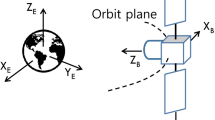Abstract
The possibilities of using of single-gimbal control momentum gyros (gyrodynes) in the control system of an advanced remote sensing satellite of the Earth are studied. The main difficulty arising in the phase of designing a composition of the motion control system for this satellite is that the gyrodynes currently produced in the Russian Federation have an angular momentum magnitude, considerably exceeding the value required for this satellite. The second circumstance is the limited range of the selected angular rate sensor, which hampers performing attitude maneuvers at high rates. Ways of solving these problems are considered and the possibility to ensure the required accuracies of stabilization in surveying the Earth’s surface is shown. The capability of this satellite to conduct areal and corridor surveys is demonstrated by the results of mathematical simulation.
Similar content being viewed by others
References
A. V. Bogachev, V. N. Platonov, and S. N. Timakov, “Capabilities analysis to ensure the accuracy characteristics of the prospective spacecraft stabilization, designed for the remote sensing of the Earth,” Kosmonavt. Raketostroen., No. 2, 83–89 (2013).
V. N. Platonov, “About accuracy of and earth remote sensing spacecraft attitude–keeping without using data from inertial sensors,” Kosm. Tekh. Tekhnol., No. 3, 33–38 (2014).
A. V. Sumarokov, “Pointing of high–resolution camera with video of the Earth’s surface from the ISS,” in Proceedings of the 17th Conference of Young Scientists on Navigation and Motion Control, Ed. by V. G. Peshekhonov (Elektropribor, St. Petersburg, 2015), pp. 561–568.
A. V. Sumarokov, “On pointing of high resolution camera mounted on the international space station using biaxial rotating platform,” Vestn. MGTU im. N. E. Baumana, Ser. Priborostr., No. 4, 85–97 (2016).
A. E. Bryson, Jr. and Yu–Chi Ho, Applied Optimal Control: Optimization, Estimation and Control (CRC, Boca Raton, FL, 1975).
V. V. Aleksandrov, V. G. Boltyanskii, S. S. Lemak, N. A. Parusnikov, and V. M. Tikhomirov, Optimal Motion Control (Fizmatlit, Moscow, 2005) [in Russian].
A. V. Sumarokov and S. N. Timakov, “On an adaptive control system for angular motion of a communication satellite,” J. Comput. Syst. Sci. Int. 47, 795 (2008).
V. V. Kul’ba, E. A. Mikrin, B. V. Pavlov, and V. N. Platonov, Theoretical Principles of Designing Information and Control Systems of Space Vehicles (Nauka, Moscow, 2006) [in Russian].
V. N. Platonov and A. V. Sumarokov, “Supplying for stabilization accuracy of next–generation spacecraft when conducting Earth surface area mapping,” Kosmonavt. Raketostr., No. 3, 125–132 (2017).
V. N. Platonov, “The law governing the system of gyrostabilizers,” in Proceedings of the 5th Conference of Young Specialists, Korolev, 1977, pp. 57–69.
J. W. Crenshaw, “2–speed, a single–Gimbal moment gyro attitude control system,” AIAA Paper No. 895 (1973).
V. N. Branets, D. M. Weinberg, V. P. Werestchagin, N. N. Danilov–Nitusov, V. P. Legostaev, V. N. Platonov, U. P. Semenov, V. S. Semjchkin, B. E. Chertok, and N. N. Sheremetyevsky, “Development experience of the attitude control system using single–axis control moment gyros for long–term orbiting space stations,” Acta Astronaut. 18, 91 (1988).
E. N. Tokar’ and V. N. Platonov, “Investigation of singular surfaces of systems of noncontiguous gyrodynes,” Kosm. Issled. 16, 675–685 (1978).
B. Wie, D. Bailey, and C. Helberg, “Rapid multitarget acquisition and pointing control of agile spacecraft,” J. Guidance, Control, Dyn. 25 (1) (2002).
V. N. Branets, V. N. Platonov, A. V. Sumarokov, and S. N. Timakov, “Stabilization of a wheels carrying communication satellite without angle and angular velocity sensors,” J. Comput. Syst. Sci. Int. 47, 118 (2008).
Author information
Authors and Affiliations
Corresponding author
Additional information
Original Russian Text © V.N. Platonov, A.V. Sumarokov, 2018, published in Izvestiya Akademii Nauk, Teoriya i Sistemy Upravleniya, 2018, No. 4.
Rights and permissions
About this article
Cite this article
Platonov, V.N., Sumarokov, A.V. Studying the Possibility of Ensuring the Stabilization Accuracy Characteristics of an Advanced Spacecraft for Remote Sensing of the Earth. J. Comput. Syst. Sci. Int. 57, 655–665 (2018). https://doi.org/10.1134/S1064230718040123
Received:
Accepted:
Published:
Issue Date:
DOI: https://doi.org/10.1134/S1064230718040123




